Colour Retoucher [Rembrandt]
by John Castle, Rembrandt Photogravure (1955-61) and Sun Printers (1961–66)
I should like to think that it might be of interest to future generations to have some light shed on what a colour retoucher did in the last century and what it was actually like to serve an apprenticeship in the printing industry in the late 1950s. Recently, while researching my family history and going through the censuses of a hundred years ago, I noticed that, after each entry, the censor wanted to know the occupation of each person. I began to wonder: just what did a Bodger do? Or indeed a Whitesmith or a Fret Cutter? These were apprenticed trades, as signified by the censor’s suffix Jr. or Ap. If someone in a hundred years’ time looks me up in the census and wonders what Colour Retoucher Ap. means, I wonder if the trail will take them to the Sun archive?
Part 1. A Toe in the Door at Rembrandt
Rembrandt Photogravure was my first job on leaving school. I had grown up in North London and attended St. Mary’s C of E School in Hendon. The only thing that I excelled in was art and I left school with a very undistinguished academic record. My father was a skilled engineer. The drab London of post-war years, together with the condemned three-roomed downstairs flat that my parents were attempting to raise their two boys in, had caused my father to seek work in one of the New Town developments that were such a feature of the newly emerging Britain. A brand new house went with the job and we moved in late 1955.
Our new home was in Hemel Hempstead, where, to my mother’s delight, we not only had an indoor toilet but also a large garden and a room each for my brother and I. The move marked a crossroads in my life: the demarcation between schoolboy and the adult world, though it was to be at least a year or two before I would trade in my school blazer and tie for a sports jacket when attending interviews or, indeed, starting work!
Getting a job was a priority. At first I tried various companies around Berkhamsted and Hemel Hempstead in an attempt to find something that would suit my artistic temperament. In fact my father came along with me to some of these interviews. I remember that at the time I had little confidence and much appreciated his presence and help with this initiation into the adult world. My father was keen on me getting an apprenticeship, and as my recent interviews had borne no fruit he remembered that one of his sisters had been married to a compositor on one of the London newspapers. My father had been told that it had proved to be a lucrative and safe job. After some research by my mother I was advised to seek guidance from Watford Technical College. I spoke with a Mr Sutherland, head of art at the college. He held out no hope whatsoever of me ever getting into the printing industry and told me so in frank terms.
At the same time I had written to Sun Printers, with little hope of anything coming from it. I was truly amazed when I received a letter back asking me to come on 29th November (1955) to Whippendell Road for an interview at the Personnel Office opposite the main entrance. I was expecting this interview to yield the same results as all my others and as I climbed the steps up to the Personnel Office I was elated but ready for disappointment. Three days later Mr Wells, the personnel manager, wrote back offering me a one month trial period to see if I was the sort of material needed to make a process apprentice. I was truly amazed! It felt like a huge accomplishment, but in fact it was only a small and fragile first toe in the door. My hours of work were to be from 8 a.m. to 6 p.m. on Monday and Tuesday, and from 8 a.m. to 5:30 p.m. on the three remaining days. The wage was £2.9.9 for the 43-1/2 hour week. On top of this I could earn a small good-conduct bonus. Actually, it wasn’t quite Sun Printers who were to give me the trial. It was Rembrandt, which was owned by the Sun but functioned autonomously, with its own management and day-to-day running.
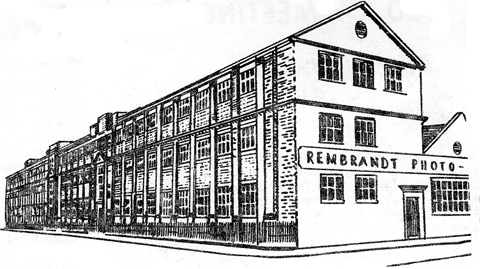
Rembrandt House.
Friday, 30th December, 1955, was a red-letter day for me. To get to the Sun at 8 a.m. meant rising at about a quarter to six. My father was up already, getting ready to go to work, and here I was now, doing the same thing. It all felt very strange and unnerving to be part of the grown-up world, knowing all that was expected of me. It had only been about eighteen months before that I had reluctantly swapped short trousers for longs!
Hemel Hempstead was about five or six miles from the Sun and to get to the Sun involved two bus routes. Apart from paper rounds I had never had to be up so early and act so much with my own initiative. The winter morning was still dark and a bit foggy as I walked the roads to the bus stop. Everything was quiet with absolutely no cars on the roads. One or two people huddled around the bus stop in Belswains Lane waiting for the bus to appear out of the murk. No lights were on in the surrounding houses and the dull-orange sodium street lights were having a struggle to penetrate the fog and gloom.
It seemed a strange adult world as I clambered aboard the green 322 ‘RF’ coach and paid my fare. Apart from the engine it was a totally quiet environment all the way to Watford. Nobody spoke and many hid behind newspapers. By the time I got off at Clarendon Road the world had started to stir but it was still a very dark and unlit Watford with few people about. A slight panic set in when I tried to remember where the next bus stop was – outside the theatre in Clarendon Road. The new bus, this time a double-decker, wound its way through the backs of Watford. When it stopped at a particular bus stop in Whippendell Road the conductor suddenly shouted out: “Hagden Lane, Rembrandt rest home”! I was soon to learn that Watfordians who were not employed in the printing industry saw us as privileged, over-paid, and under-worked! The next stop was where I got off.
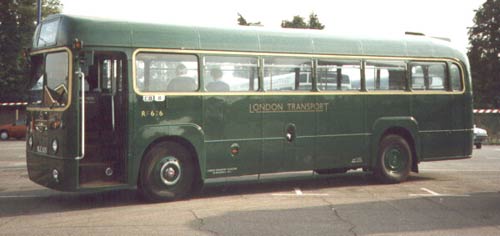
An old ‘RF’ bus.
A week before, my mother had taken me into Watford to buy me a long black overcoat. I was a bit self-conscious in this adult-looking garment, but underneath I still wore my school blazer, white shirt, and school tie! I crossed the road and once again went up the steps to the Personnel Office. This time I had my National Insurance Card and birth certificate with me instead of my portfolio.
I was told that I had to walk up to Rembrandt from the Personnel Office and introduce myself. It was a young man of my own age called Peter Walker who was assigned to (appropriately!) walk up the road with me and take me to the main Rembrandt office. Peter worked as an odd-job boy in the Studio at Rembrandt. It seemed that I was to relieve him of some of his duties in order to free him up for activities more in line with the kind of work that he was seeking in the company.
Upon arrival I was introduced to the head of Rembrandt – an imposing man called Len Cotton, whose no-nonsense manner and shrewd and penetrating gaze rather frightened me. Sometime in his life, Len had lost an arm, which added to his swashbuckling demeanor. (I rarely saw him in a suit; he wore humble attire in the form of ordinary utility brown smocks or coats.) He had an unusual voice. It was hushed and rasping with a gentle Hertfordshire burr to it. Anyway, Len got your respect, and one suspected he didn’t suffer fools gladly!
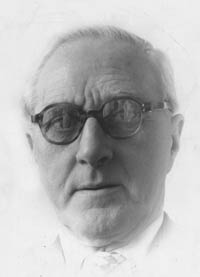
Len Cotton, works manager at Rembrandt.
After a while, Mr R. Carol, the process manager, came in and welcomed me. I was told that I would be working in the Studio. He took me upstairs, through the Retouching Room, and into his little office, tucked away in a corner of the Planning Room, overlooking the yard. He explained what was expected of me and that I should not view my appointment with any expectations of permanence. He explained how I was to ‘clock in and out’ each morning and afternoon, and gave me my ‘clock’ card. Mr Carol also frightened me a bit. He was, on the exterior, a stern, quiet, school-masterly kind of man, who took his responsibilities very seriously. Much later I realized what a private and kind man he was.
Bert, as he was known to intimate colleagues, then took me up to the Studio and introduced me to my boss-to-be. This was Bob Lawrence, who I came to admire greatly for his fairness, humour, and intelligence. Moreover, Bob had piloted Douglas Skymaster aircraft in R.A.F. Transport Command, and as I was an aviation enthusiast, he was instantly a bit of a hero to me. He ruled his department firmly but with humour. There was never any doubt as to who was in charge. He always wore a blue suit and had an air of crisp efficiency.
I was soon transferred back to Peter, who took me along to the tiny area where I would be based. It was there, in this doorless room of painted brick, high up in the ‘attic’ of Rembrandt House, that my working life began.
The so-called room was about nine feet long by six wide. At the window end it was T-shaped and went round the corner for another three or four feet. The ‘T’ was composed of a lead-lined sink with a small Ascot boiler above it, and to the left of the sink was a bit of bench abutting the wall. If you climbed on the bench and looked out of the small fanlight you looked down on Whippendell Road, a long way down. Alongside the nine-foot wall on the right was a line of largish bins and big paper sacks. It was in these that all the ingredients for making up photographic developers and fixers were stored. Indeed that was the purpose of the room. But it also served as a base for my jobs around the Studio, which was next to my door by a few feet.
Also cheek–by-jowl with my room was the service lift, where all materials were brought up. The lift was so ancient that personnel were banned from riding in it. I came to know this old lift – one of two – very well indeed.
Peter suggested that I take off my coat and blazer and I was directed to an ancient brown smock and invited to put it on. I felt like a greengrocer. It also made me feel I had been taken down a peg or two! In retrospect he must have wondered who he had here. I was so wet behind the ears, and felt that he was far worldlier than I. In fact, Peter had been at work for some time, enough to take the schoolboy edge off, and I think that he had relatives working at the Sun, which also must have given him confidence. Peter was a nice bloke and did his best to help me settle in. I think that he was waiting for a placement in the Sun Machine Room. Anyway, he started to explain my duties.
Being a Boy in Rembrandt Studio
My typical day started with stores unless I was requested to do something else. Stores meant anything from cotton wool to half-hundredweight sacks of chemical crystals and bottles of Windolene. Some operators would seek you out to tell you of a specific item that needed replacing. Most important were the glass photographic plates and the papers. In those days film was not used. I remember the different colours of the plate boxes: orange for Agfa, green or red for Ilford, and, of course, yellow for Kodak. The boxes for the papers also came in these colours, with the addition of white. There was WSG 1S; 2S, for instance. The WSG stood for White, Smooth, and Glossy. Most if not all of the paper used at Rembrandt was for the Mono Retouchers. If original copy was what they called ‘soot and whitewash’, then the operator would choose a ‘softer’ paper, which I am almost certain was identified by the 1S and 2S suffixes, to denote emulsion character. The papers were in a whole range of finishes and also sizes. Each was suited to a particular purpose. Some, like some of the plates, were line emulsions that came out black with no tone whatsoever. Then there were the big rolls of Document (Doc) paper, which was a kind of utility emulsion used where an image, for whatever reason, had to be conveyed to other people in the company but was not intended for reproduction. The Compositors used a lot of Document prints. Particularly on a Monday morning the hand cart that I used for getting the stores would be piled high with boxes of plates and papers, and it took quite a shove to get it rolling.
Sometimes stores would include sets of Ilford Tri-Colour filters, which were quite expensive. These were used in the cameras to obtain a four-colour separation set of negatives from a colour original. The filters came in small card wallets and the dyes used were extremely pure. As soon as the filters became scratched they were replaced.
There were a hundred-and-one items that the busy Studio required for its day-to-day running. Once I had done my rounds and made a stores list I would get Mr Lawrence to sign it (I should point out that in those days there was none of the modern trend of familiarity with names. Until you were a journeyman everyone was ‘Mr’ unless, of course, it was requested otherwise.). Off I would go with my trolley, trundle it noisily into the first old lift, close the doors, press the outside button, and dash down the steps to meet it at the next level. Then the next old lift would grind noisily down into the subterranean depths of Rembrandt House to places that never saw the light of day. Rembrandt was full of such passages, and of winding stairs. It was a quiet, mysterious world down there, lit dimly with bare light bulbs which cast a sickly yellowish light.
The stores was run by a small, no-nonsense storeman in a boiler suit, who regarded this non-shaving, pimply, and naive youth with disdain. You had to know precisely what you wanted, and if you didn’t you soon learned to bluff things out in a way that would at least have him guessing and hopefully give you the benefit of the doubt. He would disappear back into his store behind the counter and come back with, say, a couple of boxes of 24"x18" glass plates, which he would slap down in front of you with an attitude of ‘don’t you dare change your mind’. Soon the pile on the trolley would have grown large, especially if there were a couple of half-hundredweight sacks of hypo or metabisulphite chemical crystals on board. Once you had signed for the lot, back you went to the lifts, grinding upwards into the relative light. Everyone knew you had returned because of the dreadful racket of heavily laden metal wheels on the patterned metal floor of the lift. Unloading could be a struggle. Glass weighs heavy, and the hundredweight sacks of chemicals had to be transferred to the bins by a combination of bailing and tipping, with powder filling the air.
After the stores came the mixing of developers or the sweep-up, depending on demand. The Studio’s enemy was dust, and sweeps had to be done properly every day. Laydust was used, made of sawdust mixed with disinfectant. It was quite wet and was thrown liberally over the entire stone floor of the Studio. The gallery cameras, of which there were about six, ran on raised rails breadth-wise across the Studio. The laydust had to go under and around these. Then the sweeping began. It was such a boring chore. Then this old stuff had to be taken down and dumped in the yard.
By now it was approaching mid-morning and I would have to take orders for bread rolls. Some operators brought flasks or brewed up in their darkroom. You would be amazed at the confusions that could occur when making a list and taking money from about a dozen people, each with his own requirements or alternatives. After collecting and distributing the rolls, I could have ten minutes to myself in my room.
Then there would be the carbon rods that were used on the gallery cameras. These arc lights would work in pairs. When a switch was thrown, a solenoid would snap the points of the two rods together causing an intense white light that you had to avoid looking at. When a set of these were firing there would be a strange electric hum that you couldn’t ignore. The light would cast strange, unexpected, flickering shadows from several directions and there would be a kind of cold bluish light around the work area. White shirts looked spectacular! One of my jobs was to change these rods. Because they rapidly wore with use, they eventually got down to a stub, the operator ran out of adjustment, and the rods needed to be replaced. So I would have to check each gallery camera for worn arcs.
Other duties would include processing the Document prints during the late morning. They were for the Sun compositors and had to be done in time to catch the van to the Sun. This could get hectic. The docs came off the contact frame and were fed through into an adjoining darkroom, where a gang of us would process them. The sheets were large – maybe 2'6"x 2' or larger – and without ceremony were crammed down into the developer as if one was doing the washing. In an instant, the next sheet was placed on top. This went on until there was a pile in the ‘juice’ about half an inch thick. Then we would rotate the sheets by sliding the bottom one out and onto the top, each time pressing down all over. This took on a kind of rhythm and it was annoying if you suddenly picked up two by mistake. After about six minutes the sheets were slipped briefly through a dish of running water, then straight into the fix. After half a minute maximum, out they would come to be slapped down onto glass and squeegeed off in the pile.
The sheets would then be loaded individually into the rapid-drying oven till crisp and curling and often brown-stained. Then, if required, they were cut up and put into appropriate packets. Sometimes, if we had a late doc that had missed the van, I would have to put on my blazer and take it down to the Sun personally. One of our Sun ‘customers’ was a compositor called Mr Fossey. I became so familiar with his name – and others – but I never met any of the comps.
These forays to the Sun were an eye-opener for a young lad like myself. I always took the opportunity to explore the strange environment. To get to the Comps meant going through a series of departments. I never really found out what went on in one I particularly remember. It was a room that seemed to have a series of small vertical pumps in lines all over the floor. The scream emanating from these machines was unlike anything I had ever heard, then or since. One had to cover one’s ears to walk through. The room was not manned and this was not surprising since one could only take a few moments of the racket. Then there was a department that had the strangest of smells. I think it must have been cylinder preparation because the smell was very much like what I came to know at printing college as ‘bear’s breath’. But here at the Sun the air reeked of it. The first time I saw the big four-colour presses running was awe-inspiring. The speed and the noise were ground-shaking. I realized how cleverly these machines had been designed, to twist the endless, speeding paper to where it was needed for cutting and collating. At other times a press – possibly a proofing press – would be turning at almost zero revs and the minders would be dodging in and around the colour bays adjusting the doctor blades, etc. I had entered a totally unfamiliar world, from schoolboy to printing industry, and the strangeness to me cannot be overstated!
Employees were entitled to purchase cut-price copies of the magazines that we printed at both companies, so another of my jobs was to take magazine orders for the Studio operators and Mr Lawrence once a week, collect the money, go and get the magazines with my trolley, and give them out – another exercise fraught with potential problems! Peter Walker had made the mistake of telling me that the Sun printed Flight magazine. I was very keen to get copies of Flight but it was one of the few titles that were not sold to the workforce. Peter had contacts in the Sun and seemed to be regularly visiting, so he at first voluntarily put a copy for me in his coat as he walked through the Sun warehouse. In my ‘schoolboy’ innocence I did not quite appreciate the risk he was running on my behalf and I came to rely on getting my copy once a week till, quite rightly, he told me to get the copies myself! I wonder if he still remembers this?
Most days would see me mixing developers and fixer, as well as batches of ferric cyanide (‘ferry’, as we called it). The operators often swabbed a photographic image with ‘ferry’ to reduce its tone to balance with the rest of a four-colour set. When offering a colour set to the colour retouchers the initial tonal balance of the four colours was more important than density readings. I had been provided with notes on developer formulae and when an operator came in and asked for something like Metol, which was a developer, out would come the notes and I would set to, scooping the chemicals onto the scales and tipping them into a rubber bucket that was in the sink. Stirring to make the crystals melt took ages, and the liquid’s temperature dropped to near ice for some reason. Each mixture would have a stuff in it called Calgon, which was a thick, vaseline-coloured, extremely sticky concoction that came in brown glass jars from Johnson of Hendon. This mixture was a water softener.
Some of the other chemicals were, if I remember rightly, metabisulphite, sodium sulphite, potassium bromide, sodium thiocyanate, hydroquinone, and hydrosulphite. We also used caustic for something. This came in brown jars and consisted of little pellets that were dome-shaped, much like lentils. When a scoopful of these went into the bucket of hot water it gave out a loud yelp sound. Even though gloves were essential when working with chemicals, they still didn’t stop one’s fingers from being severely stained the colour of dark nicotine. You could always tell a camera operator by his fingers. The stain would come off, after a fashion, if you used permanganate of potash and/or pumice, but one’s hands suffered. I wonder what Health and Safety would make of it all today!
Lunchtimes, some of us trooped downstairs to the basement canteen in Rembrandt House. I used to purchase what was called a Junior Spare. The cooks would make enough of some dish and a little bit more for luck. So I literally took pot luck, depending on what had run out. But most times I would get what I wanted. I distinctly remember Anne White, who was an exceptionally pretty girl, working possibly in the accounts office at Rembrandt – or else she walked up from the Sun. All the young boys were very taken with her and as she came into the canteen with her colleagues for her lunch, any youth, including myself, would take surreptitious peeks at her. The poor girl was obviously aware of this and would walk with her arms folded almost as a protection, and holding her purse, trying to look away and talking with her girlfriends. I was astonished and delighted to see her picture in the Sun archive. It was a face that I had forgotten in the mists of time but instantly recognized once I saw it again. A strange thing, memory.
In the back yard, Rembrandt also had what was in fact a social club but had all the atmosphere of a very cosy pub. You paid only a small membership fee, but it took me quite a long time before I dared go in. I had never eaten out in my life, let alone been in a pub, and I was well out of my ‘blazer stage’ before I visited it. Much later, I enjoyed playing a lunchtime game of darts there, usually with Barry Hutton, who was in the Retouching department at the time. Or I might have a beer with Dennis Thorn, another colour retoucher. But this ‘clubbing’ was well after my stint in the Studio.
The Studio and Its Operators
Bob Lawrence’s right-hand man and deputy was the modest, easy-going, hard-working Ken Beckley. Mick Frazier and Terry Stevens were ‘top rate’ men in the Studio, meaning that they were paid top rate on the pay scale because of their experience and expertise. These men were put on any prestigious or difficult work, which often needed one of the modern vertical cameras. I believe Rembrandt Studio had two such. Each one was built into its own darkroom. These cameras were equipped to handle colour transparency artwork, whereas the galleries were for reflective flat copy only.
Each operator of the gallery cameras was allocated his own painted-brick darkroom. I was told that the shade of blue was chosen because some studio manager in the dim and distant past had decided that this colour had less chance of fogging the plates! These ancient rooms (there were eight or nine of them) abutted each other in a ‘terrace’ down one side of the studio, giving the effect of a row of faceless terraced cottages, each with a blue front door and its own resident. Suddenly, one of the doors would open and out would trundle the operator, gripping his large mahogany camera back, ready to attach it to his gallery camera. The wooden roller blind on the box would be rolled down, unmasking the plate inside. Then the operator would go round and switch his carbon lights on. The lens cover would come off and the exposure would either be guessed or timed. The lights would be switched off and the roller blind rolled up. The operator would lift off the plate box and trundle back into his ‘front door’. Whatever happened inside after that was anyone’s guess! Many a time I witnessed the operator, forgetting to shut the roller blind, nonchalantly sauntering back from his exposure, holding his box with the glass plate completely open to view! I came to know what this meant when, later on at College, I did exactly the same thing.
It was strange entering a camera darkroom. You went first into what I called the ‘air lock,’ which was a safety door system that made sure light didn’t get into the darkroom. You then knocked on the inner door and went in. If the operator was using panchromatic emulsion, then all safety lights would be out and the room pitch dark, except for the tiny red or green warning lights set into the black crackle finish of the camera. It was an unreal experience as you heard disembodied replies from the operator somewhere in the room. If he had finished his work he would snap on the safety green light, so that you could see him. There was something very mood-affecting about the interior of a darkroom. It was cosy and warm and smelt of chemicals and photographic emulsion. It also gave a misplaced sense of isolation and personal privacy. It was another world. No wonder some operators had their tea breaks in them. One or two actually smoked in them!
As for the operators themselves:
Frank Symmons was a nice old boy who used to talk to me about his exploits as a photo reconnaissance crew member in an aircraft called an Armstrong Whitworth ‘Big Ack’ during the First World War over the Western Front. He brought in photo albums of his time in the Service for me to see. I wonder what happened to those pictures? Many would be considered very rare today, especially some of his air-to-air shots.
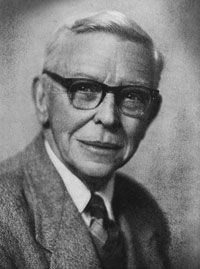
Frank Symmons, camera operator, Rembrandt Studio.
Frank Westley was an ‘old school’ operator and a gentleman who kept himself very much to himself and who I think was very close to retirement. He was a big, rather ponderous, man who, unlike the others in their greengrocer’s brown coats, wore brown dungarees with industrial-size braces, and rubber boots!
Brian Carter was a young man in his late twenties who often gave me lifts in his brand new Austin Somerset saloon car, complete with steering wheel gear change.
Peter Devenish, his friend, was also in his twenties, married I think, or at least engaged to be. He had his leg pulled because of his dashing dark good looks!
Then there was Colin Balchin. Colin was the apprentice, and almost ‘out of his time’. He, like everyone else, wore a khaki-coloured greengrocer’s coat. I remember that Colin, being short, could never get the right length of coat and he took some jibes about this. One of his coats was barely above his shoes. He was a great character and took this leg-pulling with characteristic good humour. One thing about Colin that showed: he was an extremely hard worker, dependable, committed, and great company. He was very popular with all his colleagues and very likable. I think he was also a Queen’s Scout. I remember him most of all in the Doc room, bashing out docs like there was no tomorrow and verbally holding his own against the journeymen who, mischievously, tried to ruffle him.
Another face I recall was Peter Mckintyre. He too was a very confident and able man, in his late twenties, who seemed totally unrufflable.
Bert Rump was what is known as a character. He had a dry sense of humour and somewhat pithy views. Definitely his own man. I remember he had a little toothbrush moustache.
That completes the Studio personnel as it was when I arrived. A short while later, two others appeared, namely David Hendrey and Peter Fawcett. Both of these young men had returned from their national service. I do remember that not long after I left the Studio a young man arrived called John Couzens, who was their new apprentice. It wasn’t unknown for journeymen to retrain for other departments for various reasons, and I recall a chap from Carbon Printing (I think), called Reg, who started in the Studio as well.
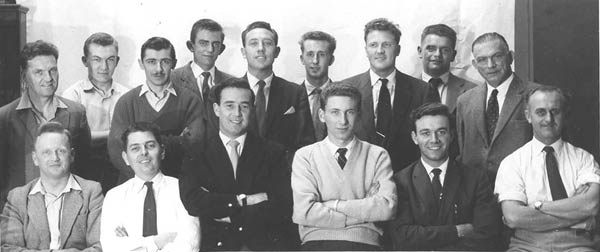
This photograph shows all
the Rembrandt Studio crew in 1957, just after my time there,
except for Bob Lawrence, Frank Symmons, Peter Devenish, and Bert
Rump.
Back row, l-r: Ivor Lafrere
(apprentice), John Couzens (apprentice), Dave Hendry (not long
out of national service), unknown.
Middle row:
Unknown
(possibly a transferee), Peter Fawcett, Terry Stevens (went on to
higher management, I believe), Mick Frazier, Frank
Westley.
Front row:
unknown, Peter
Mckintyre, Brian Carter, possibly John [?]
(I forget
the name, but he is well remembered otherwise, apprentice), Colin
Balchin (apprentice), Ken Beckley.
The Room Behind the Unmarked Door
One day I was doing a bit of exploring in the vicinity of my little chemical mixing room and, to my surprise, not seven yards from the old lift outside my door, I found another door. It was lunchtime, and on going in I discovered a long, quiet, black-painted loft. There were absolutely no windows, yet light was coming softly from somewhere. I realized that this low-ceilinged loft contained two longish and parallel rows of desks – for want of a better word. But these desks had large frosted-glass frames slanting up at an angle off the surface. The light I could detect was emanating from behind the frosted glass of some of the desks that were still switched on. In actual fact, the desk might better be described as a glass frame about six feet wide by three feet six high. The desk part was merely a shelf of varnished wood matching the width of the glass and maybe nine inches deep. Each frame structure was integral with its neighbour. Each structure had a roof that came out from the top of the frosted glass and, attached to the edge of this roof, was a black curtain that hung down behind whoever sat at the desk. Most frames seemed to be switched on when I drew back the curtain. Being lunchtime the room was completely unoccupied.
Upon exploring more – and feeling somewhat guilty – I found that each frame had an office-type padded chair. The desk structure itself was built on nests of drawers at each side with a foot-well and rail between. Ranged across the desks were sable brushes, palettes, small knife-like blades, tins of this and that, several jars of dirty water, bits of cotton wool, and pots of what looked like orange or black paint, and so on. At some desks, this arrangement was totally random. At others, the occupant was obviously more organized, as the sable brushes, knives, etc., were neatly arrayed on a carefully folded piece of cloth to one side, as if a surgeon were about to perform an operation.
Then I could see that some kind of artwork of an advertising nature was clipped to the side end wall of each frame and lit by a small strip light over it. I noted that some of the gouache paintings were very good indeed. I had never before seen such beautiful artwork for mundane things like pudding mixes and other products and services. Many of the pieces of artwork illustrated stories of romance in the pages of women’s magazines. Here and there, very large colour transparencies were propped on the glass for viewing, whilst some frames had what was an X-ray viewing box fixed on one side, where more big colour transparencies were propped. I had never in my life seen a colour transparency – plenty of box-Brownie ‘snaps’, but nothing approaching these jewel-like images.
My impression of it all was of a kind of colony, if you like, of some kind of artists, each one sitting in autonomous isolation doing some kind of skilled work. If this was one of the trades that one could become apprenticed to, I knew it was for me, even though I hadn’t a clue what it was about!
Actually, I had stumbled upon the colour retouching outpost of Sun Printers. It was entirely separate from the Rembrandt equivalent, which I had yet to explore. I was never sure why the Sun would need to have a department as such, there at Rembrandt. It operated for the Sun and had no interaction at all with Rembrandt. It was run by Fred Coles and Cyril Petts, the latter the brother-in-law of Ken Beckley of Rembrandt Studio.
Among the retouchers who worked there were Roger Austin and Alan Kimpton, both senior apprentices. Other staff are lost in my memory, but a camera operator called David Britton was assigned to them from the Sun’s Studio to service the photographic needs of the department. Dave would use my chemical mixing services, and I would do other jobs for him, such as selection of old scratch-free negs or positives to be scraped off (a messy, horrible job) and scrupulously cleaned with Windolene. These glass plates were used to sandwich colour transparencies for mounting in the colour-separation camera.
And so it was that, on such tenuous criteria, I chose to be a colour retoucher.
2. From Boy to Apprentice
During those first three months as a boy at Rembrandt I felt very insecure. Sun Printers had passed my name to the Watford District Joint Industrial Council of the Printing and Allied Trades. The previous day to my start date at Rembrandt I had had a letter from the Council inviting me to sit Part 1 of the apprenticeship selection examination. Between that date and the 14th February 1956, I succeeded in passing parts 1 and 2 of the selection. It was now a waiting game. Would Sun Printers offer me an apprenticeship?
It can be imagined that I was highly motivated to succeed. I had no relatives in the industry to champion any failures in performance. To succeed I knew it was down to me. I worked hard and conscientiously and knew that in the three months since starting I had done everything that I could do, and more, to show my bosses that they were onto a good thing! It must have been sometime towards the end of March that the bombshell dropped.
I was summoned to Personnel at the Sun, and there Mr Wells informed me that, unfortunately, there were no process apprenticeships going but that he knew of a vacancy for a machine minder apprenticeship at a company called Abbotts in Kings Langley. To say that I was upset is to put it mildly. My immediate boss, Bob Lawrence, the Studio manager, thought I worked well and felt I would be suited to the process side of printing. When I told him of the result of my visit to Personnel I could detect that, though he didn’t say much, he felt it an unfair outcome. He simply said, “Leave it with me.” I watched him snatch up the telephone, and in hindsight it was either Mr Jefferies (he of the Watford Joint Council and Rembrandt Personnel) or Mr Wells at the Sun – or maybe both of them – that he demanded to speak to. I heard nothing for a few days until I was asked, once again, to see Mr Wells at Sun Personnel.
This time, Mr Wells told me that there was a vacancy for an apprentice at Rembrandt after all. The position was in the Colour Retouching department, the area of the Process that I had set my heart on.
My father and I signed my indentures on 16th April 1956 in the Rembrandt main office downstairs, with Len Cotton countersigning. I was 16 years and four months old, and at last on my way to a real job. I was to start my apprenticeship on 24th March and it was to last five years. My pay was to be £10 per 40-hour week.
To say that I was proud of becoming a colour retouching apprentice sounds so corny in this day and age, but I WAS so PROUD! I will be forever grateful to Bob Lawrence, because he was an unstoppable force in getting me in.
It was at this stage that I realized my time in the Studio was up. I was sad to be leaving all my operator friends, but it was time to move on.
Into Rembrandt’s Colour Retouching Department
After signing my indentures I was now an apprentice colour retoucher. I had achieved this against all odds and felt that I had entered an elite occupation within an elite industry. I still found it hard to believe my success. My father, who was a skilled man and a manager in a small precision-engineering firm, had always advocated me getting a skilled job. When I decided to try printing I hadn’t the slightest idea of what was involved. Moreover, I had no knowledge of the fact that there were several printing processes, each very different from the other. The fact that I was now in photogravure was totally by chance.
On a predetermined Monday morning, I reported to Jack Barnes, Rembrandt’s colour retouching manager. Having a new apprentice was a novelty to the men in the department, as all the other apprentices were doing national service and this had meant that the men had to do all their own fetching and carrying. I would soon find myself getting the stores, rolls, magazines, sweets, cigarettes, etc., and doing the department’s ‘housekeeping’ in areas long neglected.
Rembrandt’s colour retouching room was dark and gloomy. This was not surprising, as every window had either been blocked off or painted out. Unsightly pipe-work ran haphazardly everywhere and the whole effect was one of total indifference to a pleasant working environment. Strip lights provided limited overhead light so that one could see enough as one worked at the sinks. Other than that, light was seen as the enemy, to the extent that some retouchers drew a blind across their backs whilst seated at their light frames.
As with the Studio, I had to clock in, and when I started we had to work Saturday mornings as part of the working week. I think that we started at 7:30 a.m. and pay was deducted for lateness. Jack showed me my locker and took me round to introduce me to the men. I still wore my school blazer and grey flannels! When Jack had told me all my duties I was allocated my journeyman, with whom I would spend the next eighteen months. His name was Jim Crossley. (Over the next five years I was to have at least four others, including Vic Payne and Bill Palmer.) Jim was a merry soul and kind-hearted. Rumour had it he had been a milk roundsman in his earlier life. His pride and joy was the old Standard saloon car that he patched up with masking tape and retouching black lacquer.
So there we were, Jim the journeyman and his apprentice, sitting together for large parts of the day, not two feet apart, staring into the large light frame in front of us, angled up at about fifteen degrees, with a black-painted roof running back over our heads. There was mostly total silence except for Jim’s habit of loudly clearing his pipe-smoker’s throat every 30 seconds or so. Behind us was the back of another frame, leaving a gap of maybe two feet six inches. We sat on tall padded stools. To say it was snug would be putting it mildly, and one wonders what it would have been like if one’s journeyman had liked a rear curtain, as some did.
Everything was either black-painted or dark varnished wood. The frame’s light glass was approximately eight feet wide by three feet six high, divided into two. A shelf ran along the base of this frosted glass and carried most of the paraphernalia for immediate use: palettes, Photopaque, dyes, cotton wool, sable brushes, lacquer pots, and Globe metal polish, a domestic polish (made by Rickett and Coleman) that we used for physically reducing a local area on a photographic emulsion by rubbing with a compressed paper stump. For the same purpose, we used a more ‘professional’ product called Frictol paste, which came in little aluminium tins about an inch and a half in diameter and whose contents were an attractive pale blue colour. Underneath the shelf at either end was a built-in set of drawers which were the repositories for anything the retoucher felt like putting into them, including, sometimes, shoes. My drawers, in the end, were full of colour charts, rolls of cotton wool, varnish paper, spare brushes, paperwork, lists, rubber gloves, a china mug, books, rags, Chinagraph pencils, Swan-Morton scalpel blades, and so on. One’s feet rested on a lateral wooden bar. Sometimes, if the weather was very hot, some men would sit with their feet in a bowl of water placed on the floor under their frame. It was a favourite joke to quietly pour in neat black dye from the back of the frame where one couldn’t be seen. After maybe a half hour of wiggling around in the cool ‘water’ the victim’s feet would be about a three-quarter tone!
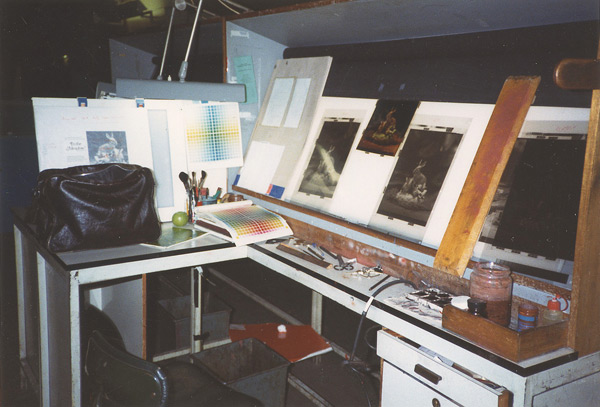
A 'modern' retouching frame (this one was at Odhams around 1968). Not so gloomy, with plenty of room and no roof as such. With more surrounding light there was not so much eyestrain. Very 'clinical' compared to the Rembrandt version!
Stuck up on the triangular walls at either end of the light frames were wads of colour charts hung by bulldog clips. Some men had photos of family, and George Brett had poems. Also on the walls were the flat copy holders. These were merely sheets of varnished plywood with a light over them. We had to view transparencies by placing them on the light frame. Later we had hospital-type X-ray viewing boxes for transparencies, with a small strip light over them for flat copy.
The middle of the room was dominated by the sinks, which were used for many things, including throwing away tea dregs. They were big lead-lined affairs with wooden slated frames lying in the base. These frames were used to rest the glass plates on whilst they washed under constant running water. For a Frost and Reed fine-art reproduction, the huge glass plate filled a sink. Later, when we used film, we had washing tanks where the film was attached to a corked Kodak clip and thrown in.
Some sinks held the large metal or plastic baths of dye which were diluted, to suit, by the retoucher. Others would hold bright yellow ferric cyanide (‘ferry’) reducing agent. A separate sink was used for the cyanide intensification of photographic images. This stuff was sloshed about with gay abandon and we thought nothing of it. A constant feature of the sinks were the dozens of chemical-sodden swabs of cotton wool, bright yellow with ‘ferry’, or dyed various shades from black to light grey, and lying messily around everywhere. They had been used for the various applications of chemicals to the photo images. Instead of disposing of them, retouchers would simply leave them, and it was the apprentice’s job to tidy it all up constantly. The messiest area of all was the huge dish of powerful solvent – completely open to evaporation – in which the black-lacquered plates would be immersed to soak the stuff off. After a while there would be more black lacquer than solvent, and it would be my job to clean the dish out, using large rubber gloves up to my elbows. What current Health and Safety would think of all this now is very predictable!
The day would come when these old sinks were ripped out and replaced with plastic units, with X-ray-type viewers instead of the waterproof light frames with which the old sinks were equipped. The department – and the rest of the process departments – also had a sprucing up in readiness for a change in the photogravure process, using a new screening technique. In the end this change didn’t come about and presaged the end of Rembrandt as such.
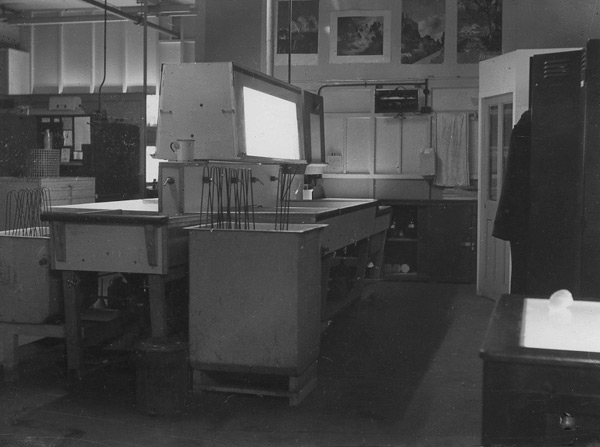
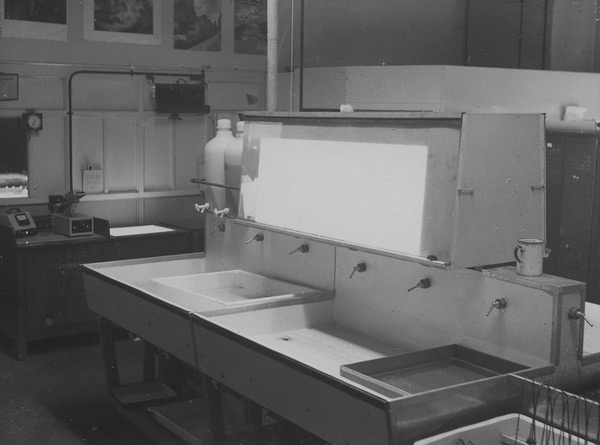
New sinks for Rembrandt’s retouchers in the late 1950s, and a rather cleaner looking room. Note the Frost and Reed prints on the wall. At least one of these was a Russell Flint. We worked from the original paintings for all F&R work, and each night Bob Carol, the process manager, would lock them in his office.
I remember that, among a whole list of titles, we worked on and printed Farmer's Weekly, Amateur Detective, Woman’s Own, Woman’s Weekly, Needles and Pins, and Jack and Jill comic. Once a year we also did the Wallace Heaton Blue Book that listed this well-known photographic supplier’s wares. We helped the Sun out at times with any work that they might find difficult to schedule. Also, once a year, we printed some first-class calendars for B.O.A.C. These were paintings by that genius of car and aircraft subjects, Frank Wootton. Sometimes he used oil paints, and we received the paintings as he finished them, so they would be completely wet and very vulnerable. They were also very large. Our prestige work came in the form of fine-art prints for Frost and Reed in London. Only the best retouchers were trusted with this work and the glass plates were enormous, literally covering the entire light frame.
Glimpses into Other Rembrandt Departments
Rembrandt Process departments were on basically two levels and it was only natural that my main dealings were with departments adjacent to my own. The top floors were used by the ‘clean’ trades such as retouching, planning, and studio. The ground floor and basement were for the more messy end, which included engravers and etchers.
The Carbon Printers was off the Glass Planning room on the top floor. Tucked gloomily away, one could almost think it wasn’t there! It was run by the extremely engaging Harry Nichols. The only other person I recall there is ‘Big Tom’. I forget his other name but I think he was related to a Sun worker. He was a large rugby type and an apprentice.
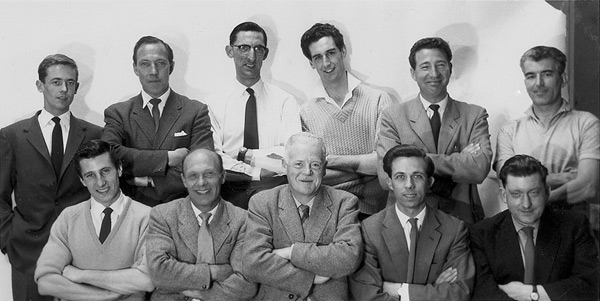
This is the
Rembrandt Rinco and Glass Planning crew, although not all are
here by any means. Missing are Eddie Baker (apprentice glass
planner) and a chap called Bob Watts. One must also include
NATSOPA member Les Athey, a very likable and obliging chap who
performed many ancillary jobs within the department. There were
lots more, but their names just will not come to me.
Back row,
l-r: Roy Heart
(glass planner, very proud owner of an immaculate red Triumph
Spitfire), Peter Darnell (Glass Planning overseer and most
affable of men), Jeff Battersby (Rinco
overseer), Roger [?] (glass planner
apprentice), Dennis McKintosh (glass planner), Ted Joyce
(Rinco?).
Front
row: unknown,
Bob ‘uncle’ Moor (glass planner?), Andy Anderson
(Rinco), John Woodard (glass planner), unknown.
The Mono Retouching department, run by Freddie Fox, was situated off the middle floor corridor, sharing a room with the Rinco planners. To my shame I can only recall two other names: Donald Stewart and a chap called Albert (Harmon?), whose bagpipe playing was a legend in the Process. He would play on many occasions in the year, including some ‘banging out’ ceremonies. He was two people, quiet and shy on acquaintance but a total extrovert given the right opportunity! At those times, he was a very funny man indeed and the life and soul of any party. There was also an elderly man whose name was Dickson or Dixon, I think, but he retired soon after I started in the Colour.
The Engraving department was run by a chap called Bruce. Others in this department were the Betts brothers, Steve and ?, and their father. (But they may have been etchers…) Then there was Martin Naylor, an apprentice engraver. He sold me his pretty Morris 8 series ‘e’ tourer which I tried to restore and couldn’t put back together! I cannot remember anyone in the Etching Department except perhaps Jack Clarry?
Not being involved in the machine room, I am not that knowledgeable in this area. I remember that we used sheet-fed flat-bed Palatia machines. These, I’m sure, were gravure machines. The Frost and Reed jobs were on high-quality stock and would never have been printed on a continuous-roll press. I guess the sheet was fed four times for each colour, but I very much stand to be corrected here. This machine room was in the basement. On a dark, wet evening whilst waiting for the homeward bus you could look down below street level, where light was pouring from the window vents, and see these machines clattering away and hear the hissing of air as each sheet was sucked up and positioned ready for printing. Of course most of our jobbing work was printed on the thundering high-speed cylinder presses. To walk through the machine room was awe-inspiring. The noise was deafening, and the ground seemed to move. One wondered how anything so fast could be so accurate!
I Start to Learn My Trade
The first thing that struck me as rather a disappointment was that, in colour retouching, actual colour was not involved at all! In my naivety I had imagined many pots of colour. Instead, we used two basic mediums. The first was Photopaque. This was a brownish-pink, water-soluble paint that, when painted on the photographic plates, rendered that area light-proof. In other words, rays of light could not penetrate.
The second medium was a water-based dye. This was used to modify an area of the photo plate to make it darker. The effect could be very subtle – the merest veil of tone – and from there could range to out-and-out black. A skilled retoucher could apply dye to the image in such a way that it appeared close to the effect of increasing photographic exposure to a selected and contained area of the film. Applied carefully, the dye’s edges remained soft and photographic to whatever degree desired. Making vignettes with dye was a very basic skill to learn, and much practice on old plates was essential. One also had to acquire the visual skills to be able to match tones. Handling of fine sable brushes to apply the Photopaque and dye took some apprentices a very long time to master.
A different way of applying dye was to mix it to the required strength in a large photographic dish and immerse the plate or film in it for as long as was deemed necessary to obtain the required depth of tone.
The De Vilbis Aerograph was another popular way to apply dye in a very controlled, photographic manner. Each retouching frame was furnished with an air supply with De Vilbis air tap. Using the airbrush needed skill and dedication. The effects could be stunning but not every retoucher felt comfortable with this application.
I was also introduced to a chemical that acted in the opposite way to dye: it removed areas of the photographic image. This bright yellow solution was the ferric cyanide I have already mentioned, and it was very poisonous. The same skills as for applying dye were involved here, and the same effects in reverse were obtained. Like dye, the ‘ferry’ could also be applied by immersing the plate or film in a dish. Experience taught how strong the dye or ‘ferry’ bath should be.
If great precision were required to apply any of these materials to a local area, the work could be done through a previously applied waterproof transparent frisket film (Transpaseal) which the retoucher stuck down onto the plate or film and then, with a surgical scalpel, cut around the areas required and peeled those bits of film off. This left exposed just those areas to be worked on.
A further method of ‘holding back’ some areas for the local treatment of others was by a material called black lacquer. This was spirit-based and dried to a tough, waterproof skin. Getting it off afterwards was a very messy business indeed. One actually painted it on with a brush but got it off in a dish of solvent.
One more basic treatment is worth mentioning. Sometimes it was quicker to locally reduce a tone by actually scraping the area with a precision-honed blade to remove a fine layer of the photographic emulsion itself. We used to get these blades from a company called Grobet in Switzerland. Later, retouchers found that a piece of silver steel rod, sharpened on a grindstone and fine-honed on a whetstone and with polishing paper, made an excellent precision blade for cutting intricate masks. You could easily cut the most intricate shapes out of masking film by simply rolling the rod between the fingers, something that couldn’t be done with a flat Swann-Morton scalpel. Skilled use with a scraper could hardly be detected, but some retouchers were never able to master its use and avoided it. Highlights in eyes could be enhanced most effectively using a scraper and, if you were feeling brave, an area about one centimeter square could be reduced in tone without the need for dye or chemical.
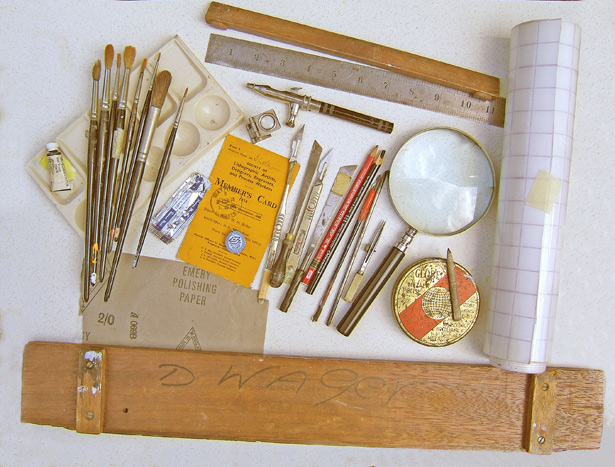
A retoucher’s tools. To the right of the paint brushes, in silver-and-blue wrapping, is a packet of Swann-Morton scalpel blades, and on the other side of the Member’s Card, are various scalpels and scrapers. Above the card is a small magnifier (known as a linen tester) and above that, an airbrush nozzle. To the right of the scrapers is a Stabilo “All” pencil (which wrote on any surface), and next to the large magnifying glass is a ruling pen nib. At the far right, beside the tin of Globe polish, is a roll of Transpaseal, a clear plastic film that was peeled off the grid-printed backing and cut as a waterproof mask by scalpel. The retouching rest – which Sun maintenance staff used to make for us – belonged to Dennis Wager, one of my colleagues in the colour retouching at Sun Printers. Photo by John Castle.
All these skills and procedures had to be learned by an apprentice, and it was the intention of the boss or the journeyman to get the apprentice’s skills to a point where he could be trusted to do basic – and this usually meant onerous – tasks without much supervision. So for the first six months I would be practicing all the above on bits of old exposed film and glass plates, pretending that I was working on the real thing. All of this had to be gone through before I even knew why I did what I did! After a week or so it was all very tedious indeed and I looked forward to being asked to run an errand, especially if it involved going down the road to the Sun.
Finally I was able to do
production work. This is where the onerous comes in. We produced
the colour comic Jack and Jill, and every week the
centre-spread pages were composed of a coloured image of some
scene or other that involved dozens and dozens of dogs, horses,
butterflies, and Jack and Jill doing something or other, and all
intertwined with an improbable leafy countryside. All of the
painting was lined out with thickish black lines. Every technique
above had to be applied to the four-colour negative set on
20"x16" glass plates. For starters, all the hundreds of lines
surrounding figures, detailing eyes, mouths, and noses, and so on
and on, had to be scraped down to the matching surrounding tone
on the red and blue
separations.* The scraping-down was necessary because the
registration wasn’t too good on the presses that were used
for this job, and a slight lack of register could produce a
terrible effect if red and blue slipped out at full strength from
under the black. Just doing this task could take me the best part
of half a week. Then, each colour had to be enhanced in some way
on all four plates, using any of the above procedures, and each
colour that made up the whole would be checked against the colour
chart. It was a case of patiently ‘crawling’ over
each plate. Finally, ALL the lines on the black printer had to be
drawn over in dye to strengthen them. After nearly a fortnight I
would be ready to present my retouched four-colour set for
checking. This meant that Jack Barnes would ‘crawl’
over everything, checking by eye and densitometer instrument that
the tones would produce the correct colour. Depending on the
perceived reputation of a journeyman, his work might not be
totally checked on the densitometer; Jack would go more by
‘if it looks right it is right’. For a lowly
apprentice like me, however, very little of my work was trusted
like this!
* ‘Separations’ was the proper technical term, although we ordinary blokes usually referred simply to ‘the red’ or ‘the blue’ or sometimes to ‘the red printer’ or ‘the blue printer’. On the shop floor one needed a term that could be said quickly and implied no pretentiousness. However, we were more likely to describe our trade as ‘colour separation’, because ‘retoucher’ was a misnomer, just an integral part of our work.
Finally, using his Zeiss glass, Jack would check that the set of plates was still in register. If it were not, we would be looking at a remake! This check was especially important when we moved from glass to film, because unlike glass, film could distort over time with heat. When the set was cleared it was sent upstairs to the Studio, where it was turned into positives and, after more retouching, the ‘crawling over’ would begin again. With some jobs it was felt that corrections would be more easily done in the positive stage, so in these cases the negs would be sent ‘wrong’ to the Studio. Judging negative tones was not easy and, invariably, some colours still needed modifying at the positive stage. Needless to say, similar procedures with dye and ‘ferry’ would then have to be done as it was hardly known for a set to go through without being touched.
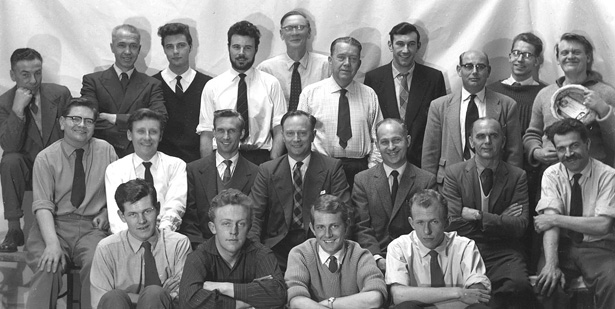
The
Rembrandt Colour Retouching personnel during my time as an
apprentice. We also had an Australian called Bob Cook who was
with us for a while. There were others, too. Aubrey Augusto (an
extremely likeable Anglo Indian), Tom Moult (a gifted artist),
Tony Roberts, Ron Barcham, Tom Shannahan (who also worked in
Canada), Barry Hutton (of the Sun Huttons), George Groves (a
transferee from Engravers), Jeff Hinds (or Hines), and Bob
Barefoot.
Back row,
l-r: Jim
Crossley (ex-milkman), Tom Dixon (Lancaster bomber flight
engineer), John Castle (me), Colin Herbert (from Bristol), Bob
[Crosby?] (his son was a planner or mono retoucher; Bob’s
claim to fame was that he was about 6’7” tall; he
also had one of the smallest dog breeds going and it was quite a
sight to see him with it on a lead!), Gerry Ireland (worked in
Canada), Dennis Thorn (I believe Dennis was in the Glorious
Gloucester regiment for his national service), Bill Palmer (one
of my journeymen, worked in South Africa), George Brett (sometime
grave digger!), Bob Glover (later owned his own photographic
shop).
Middle
row: Dawson
Piper, Maurice Simmonds (was apprenticed at Rembrandt and
rejoined the department after his national service), Peter Elliot
(who so bravely overcame his deafness; had a twinkling sense of
humour!), Jack Barnes (overseer of dept.), Arthur Jarvis, Vic
Payne (another of my journeymen, an intelligent man; I learned a
lot about life from Vic, although he would not have known it!),
Bill Cheeseman (high tour aircrew on Wellington bombers in
WWII).
Front
row: Paul
Hancock (later killed in a flying accident), Tony Petts (son of
Cyril; fellow apprentice and good friend; later transferred to
Sun Scanning Dept.; tragically, died young from smoking-related
cancer, leaving a wife and baby), Geoff Halsey (apprentice),
Roger Wise (apprentice).
I suppose Jack and Jill comic taught me the trade. Seasoned journeymen would groan if they had to retouch a set of it. Jack Barnes knew that ‘top men’ would resent being given such menial work, and so the same people always got it whilst others indulged themselves on the Frost and Reed fine-art reproductions. Of course, not all the work was of this nature and it was possible at times to send jobs through with perhaps a couple of days on them, negative and positive.
More experience allowed me to move on to more prestigious work, and by the end of the third year I was contributing a good deal to the output of the department. They were happy days, in retrospect, but there were anxieties, of course. Some days I would be bored out of my mind at the job I was doing. And then, Jack might trust me quite unexpectedly with a plum job, such as a Woman’s Own cover. Bit by bit I was becoming a competent retoucher.
3. Winds of Change
The Watford School of Printing (Watford Technical College) was a large part of a printing apprentice’s life. Other printing companies in Watford all sent apprentices for training and to gain a qualification, whether it was for the photogravure process or for photoengraving. I cannot remember lithography being included in my time, as the workshops were only set up for the aforementioned two processes. The aim was to produce committed and enlightened people for the industry’s future.
One day was set aside in the work week for an apprentice to attend classes. On top of that, one was expected to take evening classes at least once a week (I went twice a week) on such things as printing history, history of photography, and typography. The ‘Tech’ was a great place to meet other youngsters in the industry and to swap experiences.
The climax to the two years of study was obtaining the basic City & Guilds qualification in printing and printing science. The upshot of this was to give an apprentice a much broader and more modern view of things. Tony Petts and I were fascinated by the new methods. (Tony had arrived about three months after me and we shared duties in the department.) I soon discovered how parochial the average retoucher was and how ignorant of industry developments.
I remember trying to explain to one of my journeymen the concept of the Helio Klischograph, which we had learned about at college. This machine electronically scanned an image and directly engraved it onto a plastic material, giving rise to an original printing plate. Development of this concept by such companies as P.D.I. [Printing Developments Inc.] was now producing the first, fairly crude, colour separations ready for printing. The average retoucher was so sure that a machine could never do the things that he did that he scoffed at it.
When I apprenticed at Rembrandt, the only concession to technology was the densitometer for accurately assessing tones on the film or plate. One or two of the old hands despised them, considering that anyone who called himself a retoucher should be able to assess by eye. In fact, a lot of the time we did just that, but the densitometer was confirmation. It was also crucial when the job was finally checked. At this stage, dozens and dozens of readings would be made to the four colours, and the retoucher would hold his breath as his work was scrutinized like this by Jack Barnes. The plate or film would be moved around on the surface of the instrument under an arm which mounted the sensing head. The head could assess the smallest of areas.
My first six months of being an apprentice had been concerned with learning the basic hand skills and strategies of colour separation. At that time, most of the trade was relatively crude, unscientific, and very subjective. Higher management had no real idea of what we did, and because of this the department was rather viewed by senior managers with suspicion, as if we might be pulling the wool over their eyes in a strategy to keep our wages at a premium rate.
My early days at Rembrandt were still at a time when things were unhurried. We could spend time getting things right, and could take a certain pride in the skills and knowledge we applied to produce a good result. There was an eager crowding around the large first proof sheets brought up from the proof presses, with retouchers proudly identifying with any work they had been involved with. However, things were slowly changing in the industry, although most of us were in blissful ignorance of it.
The Influences of Sun Printers
Rembrandt continued in its tried and trusted way, but its parent company, Sun Printers, was a very different animal. The Sun was inextricably bound up with the Watford School of Printing, and some of the Sun staff, particularly those young men who had attended the initial courses at the School, were highly motivated, qualified, and knowledgeable, and had been promoted within the company. The Sun also, I believe, had its own experimental department, and in connection with that the name Gerald Mowbray springs to mind. The Sun had always been very ‘go ahead’ and knew that survival meant keeping abreast of the times. So before the electronic invasion, people at Sun Printers had already realized that they had to get rid of subjective hand skills as much as possible and apply more scientific methods to get their colour separation. The idea was to cut man-hours per job and give more-uniform results. Infiltration of Sun methods to Rembrandt came in the form of Sun retouching staff taking jobs at Rembrandt. Also, as mentioned previously, the Sun had an outpost in Rembrandt, staffed by Sun men, and it was inevitable that ideas should transfer.
Peter Hurren, the Sun’s colour retouching manager, was passionate about developing a new, systematic approach to colour separation, to eliminate as much handwork and subjective assessment as possible. His method was to start with the usual negative tri-colour filtrations which were always the starting point to producing four-colour separations on the camera. The imperfections and limitations of these filtrations had been the very reason that the trade of colour retoucher was needed. Kodak had been a great innovator in the field of colour masking, and their findings greatly influenced the printing trades in America as well as in the U.K. It was along their lines that Peter Hurren began to change things.
The basic idea was to create masking combinations that ‘played off’ one tri-colour filtration against another. The final correction masks would then be sandwiched in register over each of the separations in the four-colour set of negatives and/or positives. For example, the yellow printer was ‘played off’ against the blue printer, which might leave all the greens clearly separated from any red colours. A contact film from this combination would then be placed with the red printer, thereby ‘knocking back’ the greens where little red was needed. The idea was sound and the results were often impressive but, in the negative stage especially, it took a very experienced eye to see where the method was sometimes working detrimentally. The first stage was to make what was called a ‘cancellator’ to create a mask which, when placed over the printer chosen, would completely flatten the negative image to uniform blackness. This was important, otherwise maximum revealing of desired areas would not happen. From a camera operator’s point of view, this step could be exasperating, with the retoucher insisting that he have yet another try at making a cancellating mask for him. It is worth mentioning that retouchers and camera operators worked extremely closely together in all areas. A good camera operator would develop the thinking patterns of a retoucher and vice versa. Dave Britton was this kind of operator, to name just one. Ken Beckley was preeminent.
A good operator would instinctively choose the best type of photographic emulsion from several in a range so as to achieve what the retoucher wanted. A good operator would bring a new separation set of negs or positives down to the Retouching Room and explain the limitations within which he had been forced to make a compromise. He would seek advice from the retoucher and ask if he found the results to his liking. If not, the operator would have another go at maybe two colours or even the whole set. For their part, good retouchers would try their best not to give an operator unnecessary work if they could help it.
The fit of images – register – was another problem. If an operator had moved his camera settings inadvertently, it could be the devil’s own job to get a fit with any repetitions needed. Sometimes, mere temperature would cause the film stock to stretch and, again, cause a fit problem. As far as film masks were concerned, this fit problem could sometimes be got over by literally slicing the mask if the images allowed, and spreading the areas apart individually, lining up the register bars on the edges with the help of an eye glass, or abandoning the bars and ‘fitting to work’. Another ruse, depending on many things, might be for the operator to create the new overlay mask unsharp, by inserting a sheet of clear film between the first-stage mask and his new piece of unexposed film, causing a fuzzy edge to the image. This could work well at some stages, by ‘spreading’ fine lines, etc., so that the error of register didn’t show. The technique was used a lot when we had white lettering against a four-colour black background. By keeping the black printer sharp and the three under–colours ‘spread’, we didn’t run into register problems in the machine room.
There was no formula that allowed constant repetition for making a correct four-colour set. It was this kind of thing that was so frustrating to higher management, who thought always in terms of high through-put. Various combinations of masks could give quite spectacular results. The combinations would be worked out in the retoucher’s head from experience and by eye. It was a case of being inventive and of experimenting with any combination that seemed to work. The ideal goal was to produce consistent and subtle separations which blended seamlessly with the basic photographic process, unlike hand skills which, if done crudely, would show in the printing. Yet despite all of this there would still be a considerable amount of hand skill required, as the methods often created their own problems which only hand work could solve. Actually, this problem-solving produced new skills, interest, challenges, and knowledge. Some of the masking permutations, especially those that didn’t follow the book, were ingenious and clever and very satisfying to achieve. You would hear a retoucher talking of ‘double cancellators’ in combination with a ‘line flattener’ film, etc. At first, Rembrandt retouchers rather scorned these ideas that the Sun men brought with them, seeing them as a load of pretension. Many of the old school just couldn’t or wouldn’t get their heads round it.
It was about this time that we saw our first P.D.I. scans, produced by separating the colours by electronics. Like the curate’s egg, they were good in parts but had a long way to go. Management seized on them with optimistic and blinkered fervour, insisting that the scans shouldn’t need much doing to them and that we keep the hours on these to a minimum for obvious reasons. Yet those early scans could be miles out. It was amazing what faults management turned a blind eye to in order to keep the hours down. So because of these pressures to do as little as possible on the sets, many were sent through almost as seen, and it was the engravers who wound up making things right at first proof stage. Management – that is, Process management – looked askance if we told them that the sets just weren’t right and would need work done.
The End of Apprenticeship Looms
My apprenticeship and my schooling carried on. They were happy days, in the main, at the Tech. There was a wide spread of commitment from the boys. Some were extremely studious and went on to win such things as the Hunter Penrose Trophy, and their careers shone in executive positions at companies like the Sun and Odhams. At the other end were boys who attended reluctantly and were surly and put very little effort in, often because they were sons of employees within the industry and knew they would be promoted anyway so why go to all this bother? Such was the industry at that time. For someone like myself, who had left school with very little to show for it, the Tech was my education. I had to learn algebra, had to understand the physics in printing science, and had to explain myself in the written word. It also demanded commitment and endeavour, an ability to use a reference library properly, and the ability to focus one’s thoughts as intelligently as one was able to on a task in hand. As I mentioned before, I was proud of being a colour retoucher in the industry. I suppose that was because I had managed to ‘get in’ against a lot of odds (including nepotism, it must be said). I was conscientious and took an interest in the course. It very much became a part of my life for a few years and much of its influence helped me in future endeavours and has stayed with me to this day.
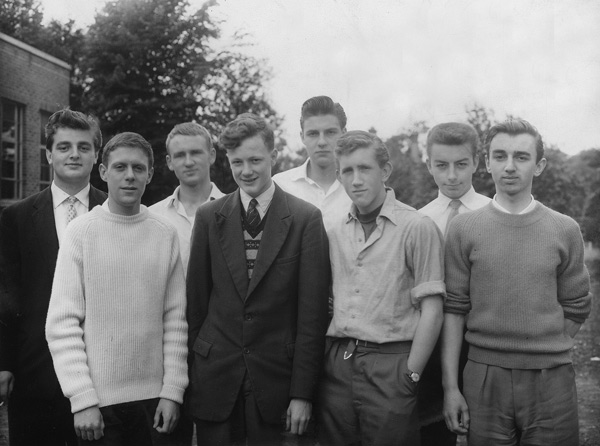
Some
photogravure (PG) and photo-engraving (PE) apprentices in the
back yard of Watford Tech., next to the Printing Department,
about 1957.
Back row,
l-r: Keith
Collins (PE), Michael Hoban (PG, mono retoucher at Sun Printers),
John Castle (PG, colour retoucher at Rembrandt), Jim Goodson
(PE).
Front
row: Barry
Barnes (PG, mono retoucher at Sun Printers), Eddie Baker (PG,
planner at Rembrandt), Russell Hurling, Brian Baker. (I think the
last two boys were from Odhams.)

We learned about early photography at college, and Tony Petts and myself spent many months making and perfecting pin-hole cameras in our lunch breaks. We would use Doc paper by the yard, pinned to a darkroom wall with an enlarger twisted sideways in order to get images that we had taken with the cameras we had made. (Or we would just blow images up high for the hell of it.) This is one of our pictures. The view from the top of Rembrandt roof looks toward Watford Town. Hagden Lane runs parallel across our view, adjacent to the end of the Rembrandt building. Incredible when you think that the image was taken with a cardboard box with a pin-hole in the side of it!
Soon we were out the other side. Most of us achieved our City and Guilds qualification and some went further to study for the ‘Full Tech’. Life as an apprentice went on the same for a while, but I was conscious that the end was nigh and was hopeful that full journeyman status would be conferred on me.
4. Banged Out!
Late one morning at work I sensed much surreptitious activity in the department. The atmosphere had changed to a kind of ‘end-of–term-ness’, where the teachers turned a blind eye for a little while.
Sure enough, it wasn’t long before I was roughly seized and dragged off to an area near the Carbon Printing department. I had been tipped off earlier in the week that this might happen, so I had worn my bathing trunks each day, just in case! Soon I was covered from head to toe in Air-Force-blue paint with suitable R.A.F. wing badge, epaulettes, and brass buttons. I was fitted with goggles, flying helmet, scarf and ‘whacko’ moustache. Finally, with a painted red nose, I was sat in a large stores trolley and given a ‘joystick’ with placard to clutch, which read ‘danger ejector’ suitably sited. The trolley had been ingeniously turned into an Emmett-like flying machine with overhead rotor and front propeller!
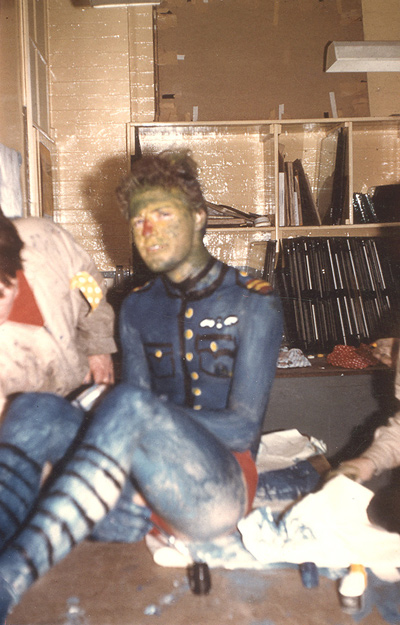
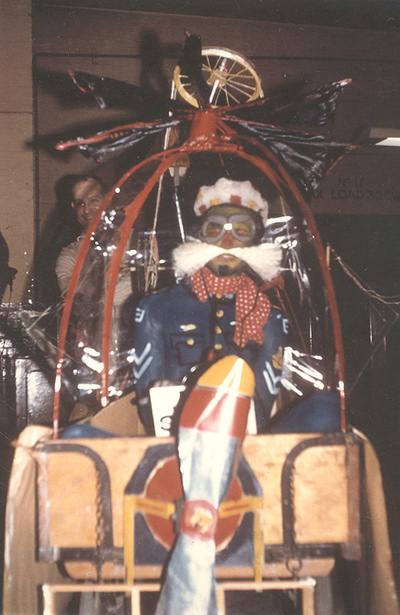
Painted from head to foot, I am banged out in 1961.
Then the noise began. In the Retouchers the men would use their retouching hand rests made of wood to bang hard on anything that made a noise. The racket was absolutely deafening as I was paraded round the top floor through the Carbon and Planning rooms. As I came past, each man and boy was banging and cheering furiously. Then it was into the lift and down to the next floor, which was the Studio. Well-known faces floated by, all cheering and banging fit to burst ear drums. Then it was into the old lift I had used as a fledgling storesman when I first started work, and down to the ground floor. Somehow, through all Rembrandt’s complex system of lifts and corridors, I visited every department. Even the office staff came out to see. The Etching and Engraving departments were last because they opened out to the back yard where deliveries and machinery came in and out. Once out, the hose was turned on me, cameras clicked, and suddenly it was all over. The crowd dispersed and those that were left escorted me upstairs to the Carbon Room where I was left to clean up and dress.
By now it was lunchtime and what better place to celebrate than the Rembrandt Club, the cosy ‘pub’ in the yard. The rest is a bit of a haze. I was not capable of work that afternoon and how I got home to my parents in Hemel Hempstead is a mystery. I certainly didn’t own a car and wouldn’t have been fit to drive anyway.
Suddenly I was a journeyman. I had achieved my goal of entering what was regarded as an elite industry, whose pay and conditions were far and away ahead of the national average. I felt the fraternity of the printing industry, with its closed-shop union membership. A standard of behaviour and commitment was demanded of me.
I was now in a world of men whose experiences and backgrounds ranged widely. Some were what one might call everyday blokes, whose horizons were little more than the industry itself within the fold of the Company. The Sun Sports Club provided quite lush facilities where one could join fellow workers for a drink and bring one’s family along. There was a thriving sports club with tennis, football, and rugby, all played at the Sun ground in Cassiobury Park. One could squeeze in a game of tennis in one’s lunch hour. And then there were the surprisingly well-educated types, some of whom had held commissions in the services. One well-known and respected colour retoucher was addressed outside work as ‘Major’, reflecting his achievement in the Second World War.
I was deeply interested in flying and this had been reflected in the theme for my ‘banging out’ ceremony. I had even taken up flying lessons at Elstree Flying Club when I was eighteen. My heroes at Rembrandt and the Sun were the flyers.
There was Frank Symmons, a photographer in the Royal Flying Corps in the First World War. Then there was Bob Lawrence, my one-time boss, who flew four-engined transport planes in the R.A.F. Bill Cheeseman had flown in Wellington bombers in the thick of Britain’s offensive in the air war against Germany. Tom Dixon had been a flight engineer on Lancaster bombers in the war and trained with the Commonwealth aircrew scheme in Canada. He always swore that his premature white hair was the result of overturning whilst landing in a Lancaster with the wheel brakes jammed on, resulting in the huge aircraft suddenly nosing over onto its back. Then there was a chap, whose name escapes me, who flew Hawker Hurricane fighter bombers in the Western Desert against the Germans. Ken Landon (of Sun Printers) would quietly tell me of his experiences as a photographer in the R.A.F. during the war. Ken had slept in Normandy fields in tents or under the wings of the Hawker Tempest and Typhoon fighters with his squadron in the Second Tactical Air Force. They helped to drive the enemy out of France and the Low Countries, using these potent machines whose rocket projectiles proved so devastating during the Fallaise Gap and Battle of the Bulge period. Ken had seen it all. He showed me photographs of his squadron taken at the German airfield of Fassberg in June 1945. He had ‘acquired’ a Leica camera in his travels and his pictures taken on end strips of gun camera film showed his squadron’s Tempest aircraft parked among Luftwaffe machines hastily abandoned during the rush to escape the wrath of the Allies. Dear Ken. His love of birds was legendary and if anyone had, or found, a sick bird you took it to Ken’s ‘bird hospital’.
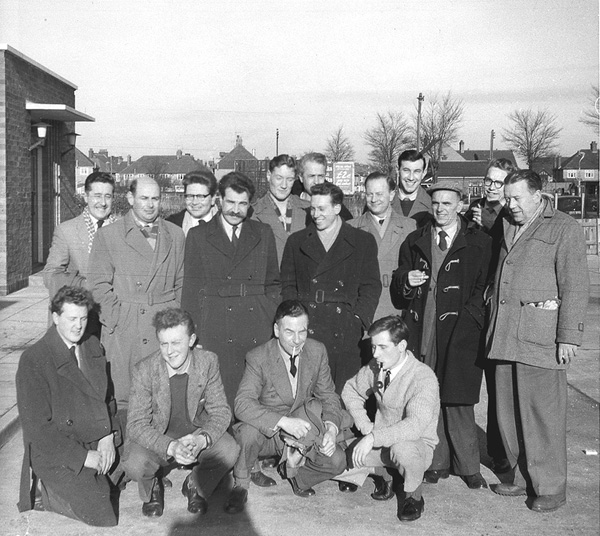
This picture was taken
outside the Highwayman pub opposite Scammells in Tolpits Lane,
Watford, about 1961.
Back row, l-r:
George Groves
(one-time engraver, now retoucher trainee), Dawson Piper, Mick
[?] (carbon printer), Tom Dixon, Jack Barnes, Dennis Thorn,
George Brett.
Middle
row: Bill Palmer, Bill
Cheeseman, Ron Barcham, Vic Payne (in black duffle coat), Gerry
Ireland.
Front row:
Mick Frazier
(Studio), Tony Petts, Jim Crossley, Don [?] (planner – and
weight lifter).
During my time in the industry I met so many interesting and gifted people, not to mention the out-and-out characters, some of whom bordered on the eccentric. The people that I met broadened my outlook and, alongside my experiences at Watford Technical College, gave me a whole new set of values and discernments. I was now among some of the earliest (for the working classes) owners of cars. Ordinary men had mortgages and lovely homes. Great discernment was shown by many for deluxe cameras and I was amazed to be introduced to the merits of the Japanese Pentax and Canon cameras. My own dear father had known none of this, and the new-found affluence of his eldest son, not to mention the fancy ideas he was rapidly acquiring, started to put barriers between us. The young can be cruel and I shudder to remember some of my attitudes to him.
Rembrandt Closes
On the 23rd May, 1961, we all had a letter from the managing director of Sun Printers to inform us that they had decided to close Rembrandt Photogravure and consolidate the workforce down the road at the Sun. They hoped to complete the move by July 3rd. My hours of work at the Sun would be 8 a.m. to 5 p.m. and my wage £21.7.0 a week.
Most of the Rembrandt staff, to my knowledge, transferred, and for a while we felt like refugees, dotted about the Sun departments, trying to integrate. Many felt uncomfortable at first, as the Sun, as I mentioned before, had a more rational approach to the Process side. Many of us had a lot of catching up to do, particularly in the Colour Retouching.
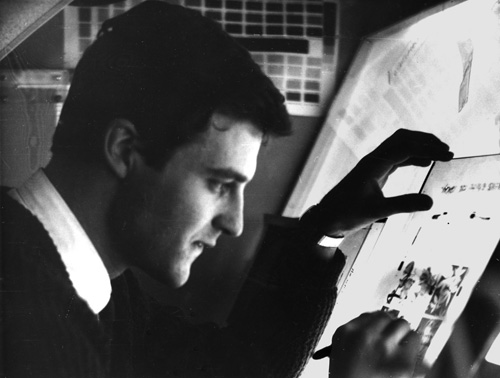
At work at my retoucher’s frame, which I shared with Brian Gentle.
So ended my days at Rembrandt. The old building is thankfully still there as I write. I know that I would be devastated were it to be pulled down. In my head I can still walk round much of it. I enjoyed my years at the Sun, but in my heart I was and always will be a Rembrandt man!
Postscript
I worked later at Odhams and found the workforce there to be of a different ‘type’ – if I may put it like that. The difference between the two companies is hard to pin down but I think it stemmed from the legacy of the pioneers of photogravure at Sun and Rembrandt. It produced a certain ethos amongst the workforce which, though steadily watered down over the years, was still there in my time.
While I was at Rembrandt and the Sun I met hundreds of people in the industry. Like myself, many of them are in retirement, and I am sadly aware that even more have passed away. I can still recall many of their voices and see their faces as they were then and as they still dwell, ageless, in my mind’s eye. It’s the names that I have problems with. They are ‘in there’ but the difficulty is accessing them! I often consult my old pal and fellow colour retoucher Peter Gardner, who now lives in Viet Nam, to help me put a name to a memory or a face, and when he comes up trumps I have to say, ‘of course it was!’
John Castle, Woking, Surrey, U.K. Feb 2008.